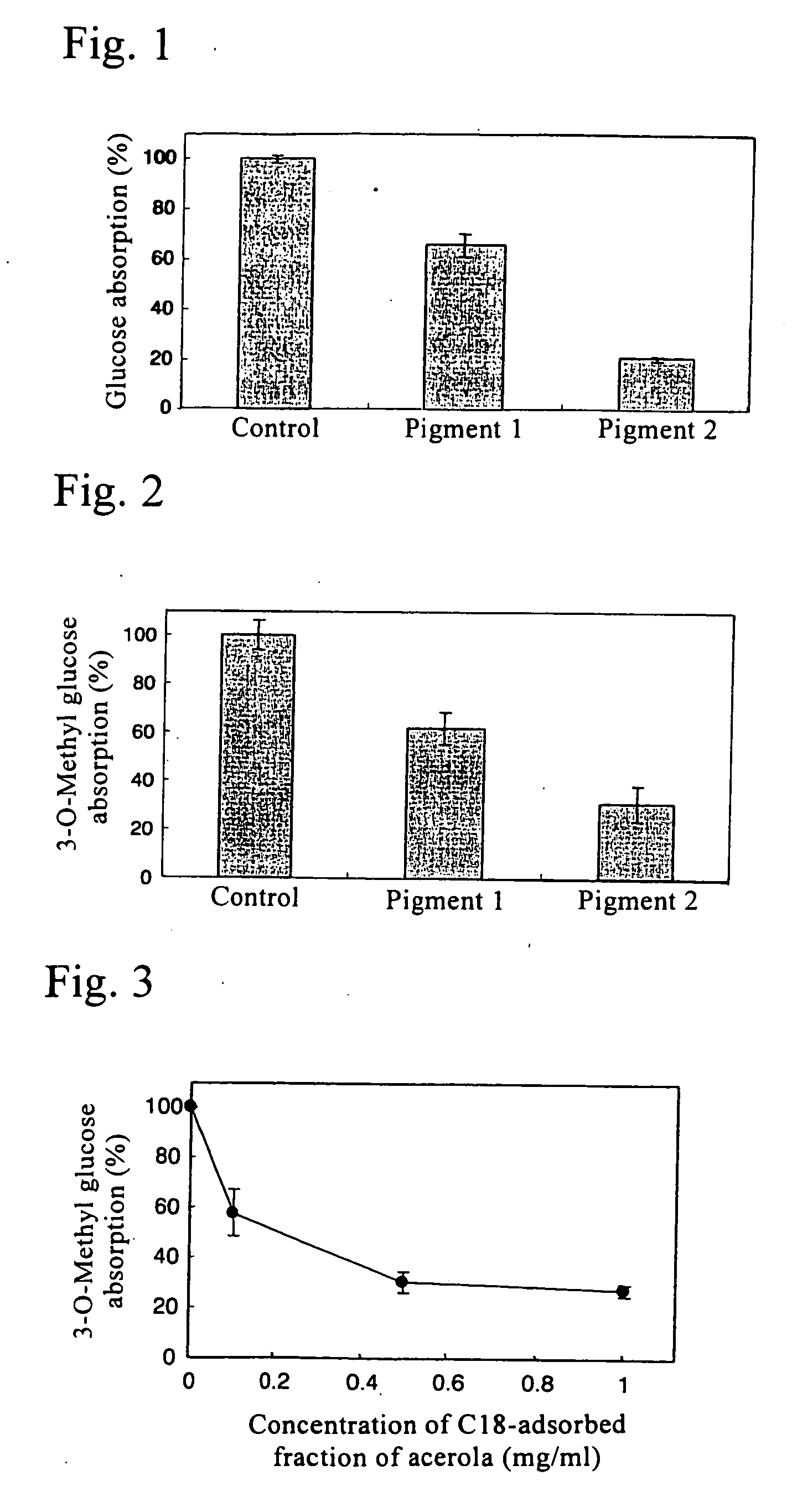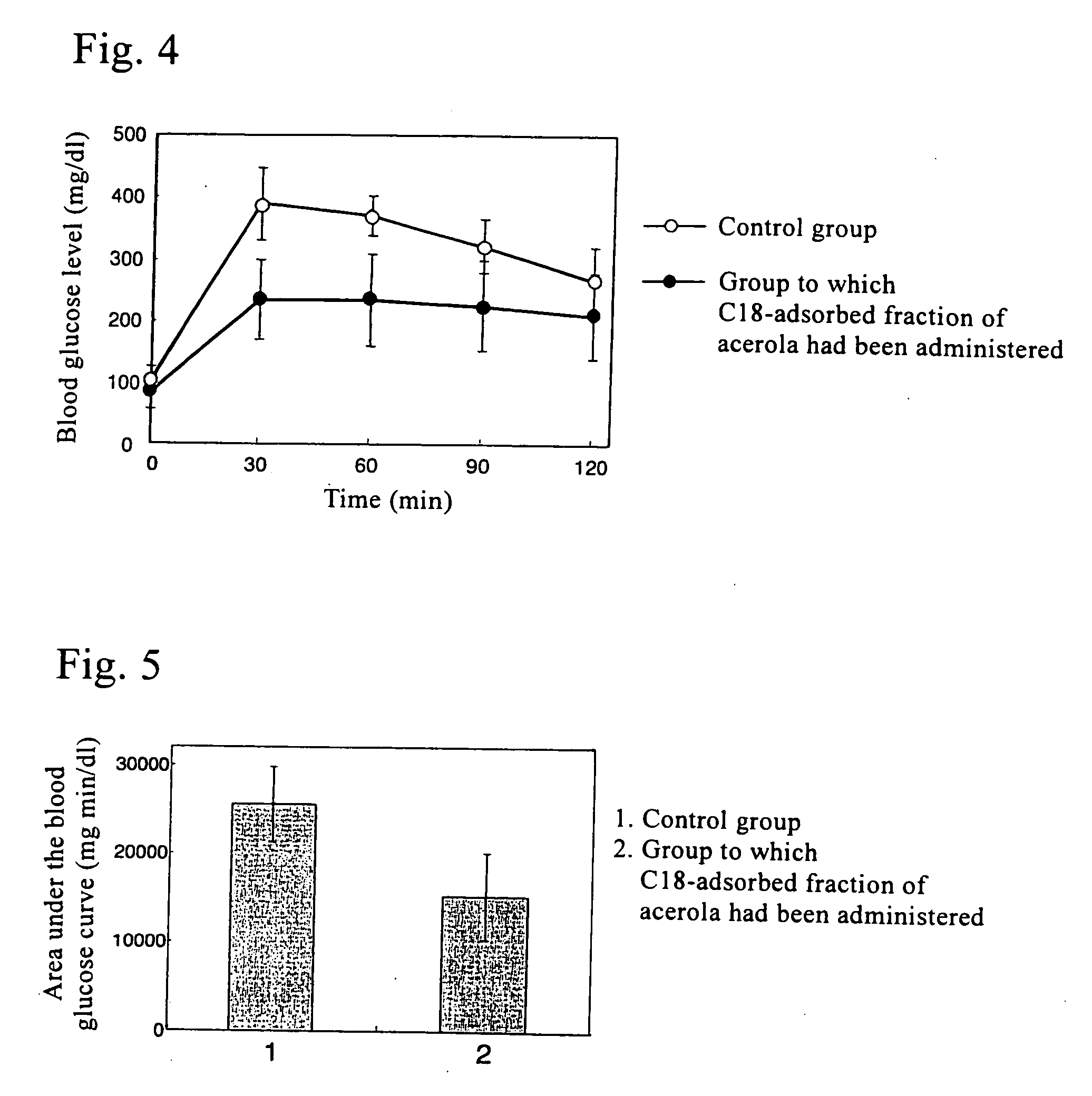Inhibitor of glucose absorption and method for producing the same
a technology of inhibitor and glucose, which is applied in the direction of biocide, drug composition, metabolic disorder, etc., can solve the problems of irritating the pancreas, requiring insulin for overconsumption of glucose, affecting the appetite of patients, and affecting the effect of insulin resistan
- Summary
- Abstract
- Description
- Claims
- Application Information
AI Technical Summary
Benefits of technology
Problems solved by technology
Method used
Image
Examples
example 1
Preparation of C18-adsorbed Fraction of Acerola
[0050] Seeds were separated from acerola fruits, the remaining edible parts were homogenized, and 3× amount of methanol was added thereto, followed by 1-hour extraction. This procedure was carried out twice, and the extract was centrifuged, filtered, lyophilized, and then diluted in distilled water again. The resulting solution was applied to the C18 cartridge columns (BAKERBOND spe®, C18 disposable columns), washed with distilled water, eluted with a 0.2% TFA / methanol solution, and evaporated to dryness to obtain an extract. The resulting extract was designated as the C18-adsorbed fraction of acerola. The polyphenol content in the C18-adsorbed fraction of acerola was measured by the Folin-Denis method, and it was consequently found to be 22.7%.
example 2
Purification of Acerola Pigment Component
[0051] Acerola juice was centrifuged, filtered, applied to the C18 cartridge columns (BAKERBOND spe®, C18 disposable columns), and washed with distilled water. Thereafter, the C18-adsorbed fraction was eluted with a 0.2% TFA / methanol solution and then subjected to separation and purification via HPLC. HPLC conditions were as follows.
[0052] Column: Inertsil ODS-2 columns (10.0×250 mm)
[0053] Column temperature: 40° C.
[0054] Mobile phase A: 0.5% TFA / water solution
[0055] Mobile phase B: 0.5% TFA / acetonitrile solution
[0056] Gradient: linear gradient of mobile phase B from 0% to 100%
[0057] Flow rate: 2 ml / min
[0058] Detection: 520 nm
[0059] Through this procedure, 2 pigment components exhibiting absorption at 520 nm were observed. These 2 components were designated as pigment 1 and pigment 2. Pigment 1 and pigment 2 were further purified and subjected to NMR analysis. This revealed that pigment 1 was mainly composed of cyanidin-3-rhamnoside ...
example 3
Test of Glucose Uptake by Cultured Caco-2 Cells Derived from Human Intestinal Tract
[0060] Cultured Caco-2 cells derived from human intestinal tracts were monolayer-cultured on a plate for about 10 days and then differentiated. A DMEM medium containing 10% fetal calf serum was used. Pigment 1 and pigment 2 (250 μg / ml each) were added to the differentiated Caco-2 cells, the resultants were preincubated for 15 minutes, and 3H-labeled glucose or 3-O-methyl glucose was then added thereto, followed by incubation for 10 minutes. 3H incorporated into the cells was analyzed to determine the amount of glucose or methyl glucose transported. The results are shown in FIG. 1 and in FIG. 2 as relative values (%) in relation to the controls. As is apparent from these figures, pigment 1 and pigment 2 mainly composed of the acerola-derived polyphenol specifically inhibited the glucose and 3-O-methyl glucose transportation. Subsequently, the C18-adsorbed fraction of acerola (up to 1 mg / ml) was added ...
PUM
| Property | Measurement | Unit |
|---|---|---|
| temperature | aaaaa | aaaaa |
| temperature | aaaaa | aaaaa |
| temperature | aaaaa | aaaaa |
Abstract
Description
Claims
Application Information
 Login to View More
Login to View More - R&D Engineer
- R&D Manager
- IP Professional
- Industry Leading Data Capabilities
- Powerful AI technology
- Patent DNA Extraction
Browse by: Latest US Patents, China's latest patents, Technical Efficacy Thesaurus, Application Domain, Technology Topic, Popular Technical Reports.
© 2024 PatSnap. All rights reserved.Legal|Privacy policy|Modern Slavery Act Transparency Statement|Sitemap|About US| Contact US: help@patsnap.com









